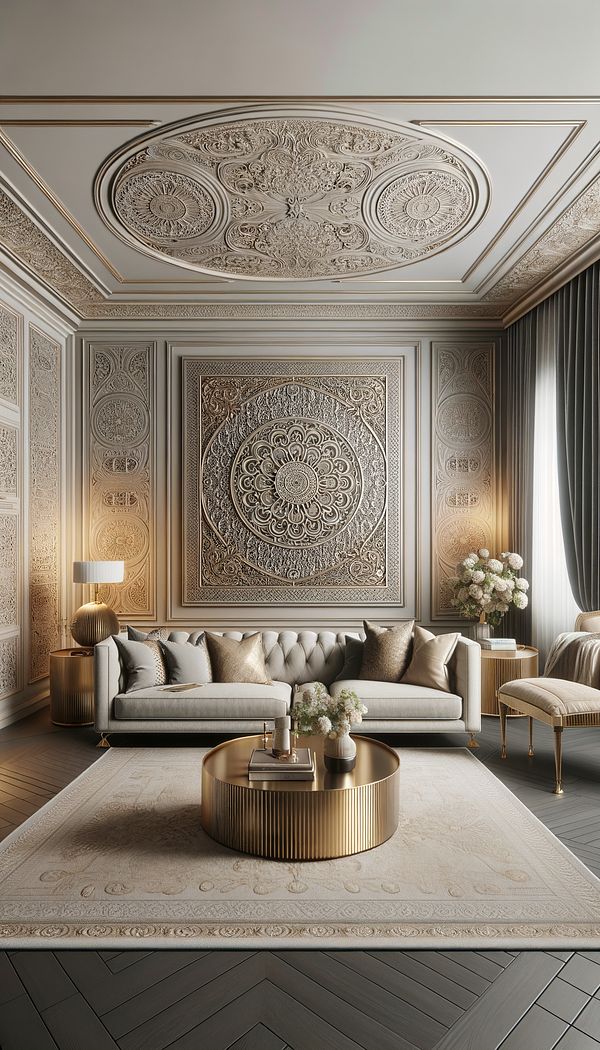What is a Guilloche?
Guilloche is a decorative technique involving intricate, interlacing patterns.
Description
Guilloche, pronounced "ghee-oh-sh", is a captivating decorative technique that showcases intricate, interlacing patterns. It’s characterized by precise, repetitive designs, often resembling braided or woven motifs. The technique takes its name from the French word for 'engine turning,' which hints at its roots in mechanical engraving processes. Historically, guilloche was achieved through the use of a lathe or engraving machine that mechanically etched patterns onto metal, wood, or other materials. Today, these patterns can also be replicated digitally, bringing the beauty of guilloche into the modern era of design.
In interior design, guilloche patterns are celebrated for their complexity and rhythm. They can be featured in a variety of applications, from the embellishment of furniture and decorative objects to architectural elements like moldings and panels. When applied to surfaces, guilloche can impart a sense of movement and depth, transforming a simple space into an opulent environment. Moreover, depending on the scale and colors used, guilloche can either stand out as a focal point or serve as a subtle background texture, making it a versatile choice for designers.
Usage
Building on its historical significance and aesthetical appeal, guilloche finds its way into contemporary interior design through various mediums. For instance, it might appear in the decorative inlay work on high-end furniture pieces, engraved detailing on metal hardware, or as a pattern on wallpapers and textiles. Guilloche patterns can also enhance the visual impact of flooring through parquetry or be used in the detailing of lighting fixtures.
FAQs
-
Can guilloche patterns be applied to any material?
Yes, guilloche patterns can be applied to a wide range of materials, including metal, wood, glass, and textiles. The choice of material depends on the desired aesthetic effect and the specific application in interior design.
-
How are modern guilloche patterns created?
Modern guilloche patterns can be created both through traditional mechanical engraving techniques, using lathes and engraving machines, and through digital methods. Digital tools allow for the replication of the intricate designs with high precision and on a variety of surfaces.
-
Is guilloche exclusively used in luxury interiors?
While guilloche is often associated with opulence and luxury, it can be incorporated into a variety of interior design styles. Its application can range from subtle decorative elements in minimalist spaces to bold focal points in more lavish settings.
Practical Application
To incorporate guilloche into your design, start by considering the scale and color scheme of your space. Small-scale guilloche patterns can add texture and interest to a room without overwhelming it, making them suitable for accessories like cushions or decorative trays. For a more dramatic effect, opt for larger, bolder guilloche patterns on feature walls or statement pieces of furniture. Remember, the beauty of guilloche lies in its detail, so choose applications where the intricate patterns can be appreciated up close.
-
Architectural Elements199 articles
-
Furniture Types599 articles
-
Decorative Techniques322 articles
-
Fabrication & Craftsmanship133 articles
-
Wall Treatments & Finishes157 articles
-
AcroteriumAn acroterium is an ornamental pedestal or statue located at the apex or corners of a building's roof.
-
OrgandyOrgandy is a lightweight, sheer, crisp fabric made from cotton or polyester.
-
Hollywood RegencyHollywood Regency is a design style characterized by luxury, glamour, and opulence.
-
Reclaimed WoodReclaimed wood is recycled wood that has been repurposed for new uses.
-
Louis XIIILouis XIII is a style of interior design and architecture originating in France during the reign of King Louis XIII.
